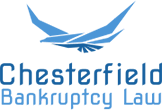CHESTERFIELD BANKRUPTCY
CHAPTER 13 VS. CHAPTER 7
WHAT IS THE DIFFERENCE?
Bankruptcy may sound intimidating, but it can help you get out of an unbearable financial situation. Chesterfield bankruptcy can be a powerful and useful tool when used appropriately. The many different types of bankruptcy offer individuals and business owners various options that can address many different situations. Questions to ask yourself when considering bankruptcy:
- Do I make too much money to file Chapter 7?
- Have I cut out non-essential expenses (dining out, high-end cable packages, etc.)?
- Do I have enough debt for Chapter 13?
- Do I have substantial debt that bankruptcy doesn’t cover (alimony, child support, etc.)
- Have I tried working with creditors regarding payments?
These are questions your Chesterfield bankruptcy attorney will ask and can help you understand where and how you’ll be making financial changes.
Two of the most common types of bankruptcy are Chapter 7 and Chapter 13. Here, we discuss some of the main differences between the two to help you better understand what bankruptcy can accomplish and what may be right for you and your family.
The main difference between Chapter 7 and Chapter 13
Chapter 7 focuses on wiping out (discharging) unsecured debt, such as credit cards and medical bills. The goal of Chapter 13 is to help you catch up on missed payments on secured debt (i.e. mortgage and car payments) while wiping out unsecured debt. Keep reading to learn more about whether bankruptcy in Virginia is right for you.
WHAT IS CHAPTER 13 BANKRUPTCY?
Chapter 13 bankruptcy, also known as a wage earner’s plan, requires you (the filer) to have a steady stream of income even if that income is not enough to keep up with bills. The bankruptcy process examines and reorganizes your debt to simplify and even reduce payments.
A Consolidated Plan for Debt Elimination
Some of the key components of a Chapter 13 bankruptcy include:
Reorganize Debt
All debt is examined together. It can be consolidated or otherwise modified to make it possible to make payments.
Repay Debt in 3 to 5 Years
The main component of Chapter 13 bankruptcy is the payment plan. Work with your attorney and a trustee to design and approve a plan that addresses creditors and determines a timeframe and amount for repayment of debt.
Keep Your Home and Vehicle
Property is protected under a Chapter 13 bankruptcy as long as monthly payments are made on time.
Protect Co-Signers
If you have debt that includes a co-signers or co-debtors, your Chapter 13 bankruptcy will not affect them
Allows for Past & Future Bankruptcy
It is possible to file for Chapter 13 bankruptcy even if you have filed for another bankruptcy recently.
CHAPTER 7 BANKRUPTCY
Discharge Debt for a Fresh Start
Chapter 7 bankruptcy is typically appropriate for those who do not have a steady stream of income or otherwise simply do not have the ability to pay. Filers must meet certain income limits; those who make too much will likely have to pursue a Chapter 13 bankruptcy.
Some of the main elements of a Chapter 7 bankruptcy include:
Liquidation of Assets
a Chapter 7 filing does involve decisions about selling assets to obtain money to pay debts, Though it can be possible to retain your home and car.
Discharge of Debt
This is the primary benefit of a Chapter 7 bankruptcy. Debt is erased at the end of the process. Debtors do not have to pay, and creditors will not continue to seek payment.
Quick Bankruptcy Timeframe
While it can take years to fulfill the obligations of a Chapter 13 bankruptcy, the Chapter 7 process is more straightforward. It typically takes only three to five months.
STOP THE CALLS!
CHAPTER 13 & CHAPTER 7 BANKRUPTCY
If you or someone you love is struggling under the weight of debt, bankruptcy may offer a way out of the stress and suffering. Bankruptcy can be an effective tool to address your debt and find a fresh start to your financial life. Contact us today to learn more about the bankruptcy process in Virginia and find out what options may be available to you.

IN CHESTERFIELD, VIRGINIA?
NEED A CHAPTER 13 OR CHAPTER 7 BANKRUPTCY ATTORNEY?
CONTACT US TODAY!
The attorneys at Chesterfield Bankruptcy Law can help you determine if bankruptcy is the right debt relief option for you.
Bankruptcy is a last resort. There may be alternatives that can help you deal with the financial burden. Call us at 804-706-1355 for more information and to find out if bankruptcy is the best option for you.
